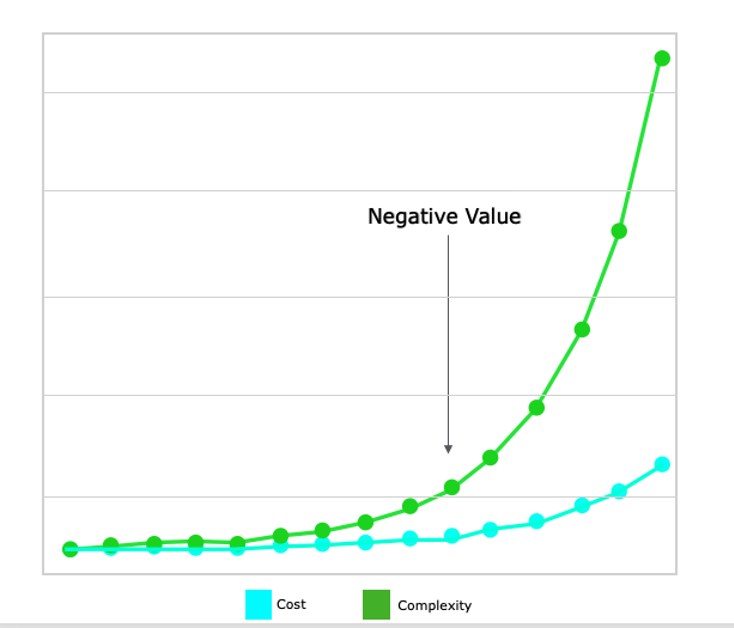To determine the worth of any technology, look at the specific value drivers. While you may think that the technology itself provides value, in many instances it does not. Worse, it could actually drive a negative ROI. Many examples of this exist in the history of IT.
AIOps is no different. While this new category of technology is based on traditional management and monitoring, the new features and functions that include the use of AI and data analytics require a deeper dive.
Here's how to define the value drivers of AIOps and what they will likely mean to you, to help you evaluate select the right AIOps tool for your enterprise.
1. Helping with complex environments
AIOps tools are most valuable to IT operations with high levels of complexity and heterogeneity. In other words, a higher number of system patterns in the operational domain equates to a higher need for AIOps.
While complexity can vary a great deal from company to company, it is certainly a factor in widespread adoption of cloud services, particularly multi-cloud deployments. And the more complex, the more costly the deployment is (see Figure 1).
Figure 1: The relationship between complexity and cost. Note the point where you reach negative value. Source: David Linthicum
There are two ways to deal with complexity. First, resist the need to deploy complex architectures. This means mandating that a single cloud platform is leveraged.
Second, you can adapt and deal with the complexity using automation and ops-related tooling. This solution doesn't reduce the complexity itself, but it helps you deal with it. It uses an operational layer that abstracts the back-end native interfaces that holistically become part of the complexity.
2. Leveraging automation features
While all AIOps tools have some sort of automation, they vary greatly, ranging from simple APIs to complete process and programming engines. Some tools have "canned" processes for self-healing—for example, automatically restarting a network device. With other tools you will need to create, test, and receive audit trail reports of what action was conducted.
The more automation an AIOps tool can provide, the more value the tool will bring. Automation capabilities can comprise up to 40% of the overall value, when you look at the ROI delivered to the enterprise. (There's an approach for determining ROI in the next section.)
3. Estimating the ROI of AIOps
Most AIOps tools have a quick ROI—usually less than six months. When building a business case, focus on the "as is" state, and then on the "to be" state with the AIOps tool. The value lies in the inefficiencies you remove between the two.
Consider the table below. This is a rough calculation of the ROI gained from deployment of AIOps tools. However, it's most of what you'll need to estimate the value of AIOps, which is always the improved efficiency that the tool or tools can bring.
Table 1: Example of determining the value of AIOps. Source: David Linthicum
You need to know some historical operational data, such as the average number of ops incidents during a specific period. Also, understand which incidents are resolved by humans and how quickly they are resolved (as is). Then plug in the expected increase in efficiency through the use of the AIOps tool(s).
While this is up to the enterprise to determine, a reasonable range to expect would be a 30% to 40% increase in efficiency.
Finally, you need to understand the "as is" cost of humans, considering that part of the ROI accrues from saving time and money by using automation and abstraction. This includes the human time spent to resolve issues. You can see the calculation used above.
Again, this is only an example. You'll need to look at the models that most accurately reflect your situation.
4. Leveraging connectivity capabilities
Connectivity to systems in an operational domain also varies. Keep in mind that this is connectivity you don't want to create yourself. The fastest path to deployment includes an out-of-the-box tool that tests connections to common systems (including Amazon Web Services S3, SAP, Kubernetes, etc.).
The value of connectivity is easy to determine, considering that it's really just two data points: the ability to connect to a specific system under management, and the ability to get at all the data required to monitor and manage that system. An example is the ability to gather operational data over time, as well as the ability to directly control the system using an API.
5. Supporting observability
The concept of observability has evolved over the years. At its core, observability monitors the internal states of systems using externally exhibited characteristics of those systems. It can also predict future behavior of those monitored systems. By manually monitoring what has happened, enterprises can reactively fix the issues.
In contrast, AI-assisted observability helps predict issues before they become issues, which helps build a proactive enterprise. The ultimate goal of automating observability is to build hyper-automated, self-healing enterprises.
Obviously, this is a key value point for those who leverage AIOps. Observability is the next set of capabilities that AIOps now provides or will soon provide. To use these features to their fullest, you should understand what observability means to your IT deployments now, as well as what it will mean in the near and far futures.
6. Leveraging application monitoring
Most AIOps tools move from simple infrastructure monitoring to infrastructure and application monitoring. If there is no need to monitor applications in your operational domain, you should not go down this path with your AIOps provider. It just adds cost and risk.
However, if it is needed, then it should provide a value you can measure. An example would be the ability to automatically restart application threads without restarting the entire application. This saves money and time, and the value of that money and time becomes the value of the application monitoring capabilities.
7. Supporting specialized systems
Consider AIOps tools that can monitor specialized systems. This could include purpose-built databases, containers, serverless systems, and other nontraditional infrastructure that should be monitored and managed in a specific way.
Again, you may have a need for this, and thus can assign a value. However, if it's not a requirement now, consider the fact that many systems are moving in this direction. The ability to include specialized monitoring capabilities within your AIOps target systems could save a great deal of money and time, considering that you won't need other tools to handle this issue, nor need new staff or training.
8. Providing root-cause analysis
This is a key value of AIOps that many people overlook during the tool selection process. This feature gets to the primary cause of a failure, such as a storage system crash that manifests in database errors, and how the experience of that scenario can teach the system to avoid the elements that led to the crash.
Next steps
The use of AIOps tooling is an evolution of the traditional operational monitoring and management that we have dealt with for years. What's different now is that the use of AIOps tools lets you apply a force multiplier to the challenges of today's complexity, security, performance, heterogeneity, and distribution.
The systems under management will continue to change. Complexity and growth will continue to be the norm. You need to get a sound operational approach in place and deploy tools that support your approach. The next 10 years will be critical.
Read Next: Buyer's Guide to AIOps Management Tools
Keep learning
Choose the right ESM tool for your needs. Get up to speed with the our Buyer's Guide to Enterprise Service Management Tools
What will the next generation of enterprise service management tools look like? TechBeacon's Guide to Optimizing Enterprise Service Management offers the insights.
Discover more about IT Operations Monitoring with TechBeacon's Guide.
What's the best way to get your robotic process automation project off the ground? Find out how to choose the right tools—and the right project.
Ready to advance up the IT career ladder? TechBeacon's Careers Topic Center provides expert advice you need to prepare for your next move.




